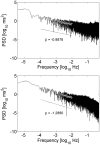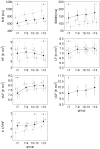Unexpected course of nonlinear cardiac interbeat interval dynamics during childhood and adolescence
- PMID: 21625487
- PMCID: PMC3098842
- DOI: 10.1371/journal.pone.0019400
Unexpected course of nonlinear cardiac interbeat interval dynamics during childhood and adolescence
Abstract
The fluctuations of the cardiac interbeat series contain rich information because they reflect variations of other functions on different time scales (e.g., respiration or blood pressure control). Nonlinear measures such as complexity and fractal scaling properties derived from 24 h heart rate dynamics of healthy subjects vary from childhood to old age. In this study, the age-related variations during childhood and adolescence were addressed. In particular, the cardiac interbeat interval series was quantified with respect to complexity and fractal scaling properties. The R-R interval series of 409 healthy children and adolescents (age range: 1 to 22 years, 220 females) was analyzed with respect to complexity (Approximate Entropy, ApEn) and fractal scaling properties on three time scales: long-term (slope β of the power spectrum, log power vs. log frequency, in the frequency range 10(-4) to 10(-2) Hz) intermediate-term (DFA, detrended fluctuation analysis, α(2)) and short-term (DFA α(1)). Unexpectedly, during age 7 to 13 years β and ApEn were higher compared to the age <7 years and age >13 years (β: -1.06 vs. -1.21; ApEn: 0.88 vs. 0.74). Hence, the heart rate dynamics were closer to a 1/f power law and most complex between 7 and 13 years. However, DFA α(1) and α(2) increased with progressing age similar to measures reflecting linear properties. In conclusion, the course of long-term fractal scaling properties and complexity of heart rate dynamics during childhood and adolescence indicates that these measures reflect complex changes possibly linked to hormonal changes during pre-puberty and puberty.
Conflict of interest statement
Figures






References
-
- Malik M, Camm AJ. Armonk, NJ: Futura; 1995. Heart rate variability.
-
- Poon CS, Merrill CK. Decrease of cardiac chaos in congestive heart failure. Nature. 1997;389:492–495. - PubMed
-
- Ivanov PC, Amaral LAN, Goldberger AL, Havlin S, Rosenblum MG, et al. Multifractality in human heartbeat dynamics. Nature. 1999;399:461–465. - PubMed
-
- Task Force of the European Society of Cardiology and the North American Society of Pacing and Electrophysiology. Heart rate variability: standards of measurement, physiological interpretation, and clinical use. Circulation. 1996;93:1043–1065. - PubMed
-
- Pincus SM, Goldberger AL. Physiological time-series analysis: What does regularity quantify? Am J Physiol. 1994;266:H1643–H1656. - PubMed
Publication types
MeSH terms
LinkOut - more resources
Full Text Sources
Medical
Research Materials

